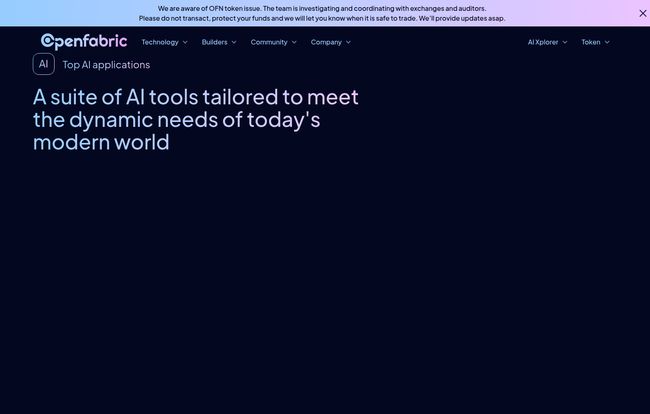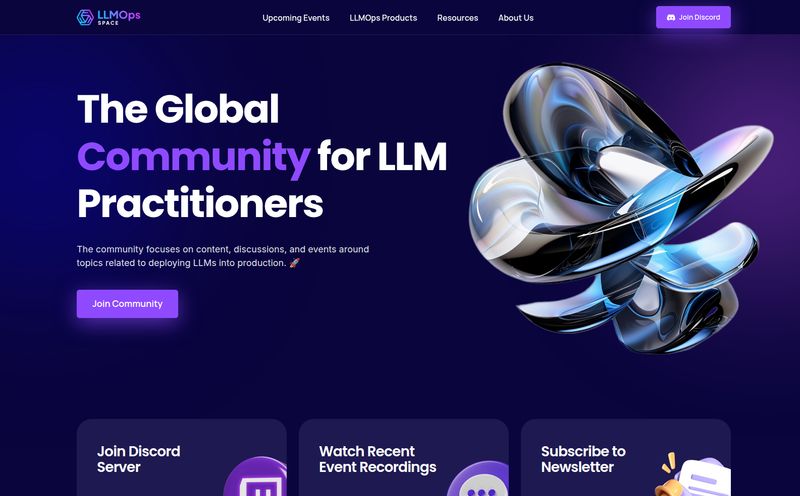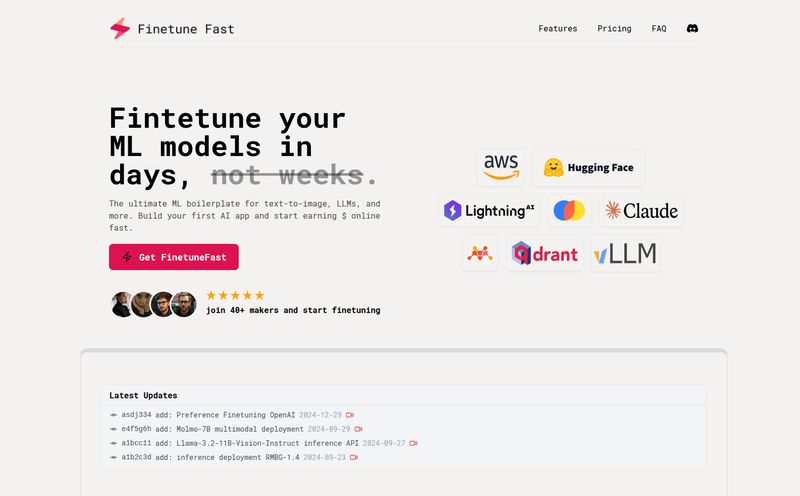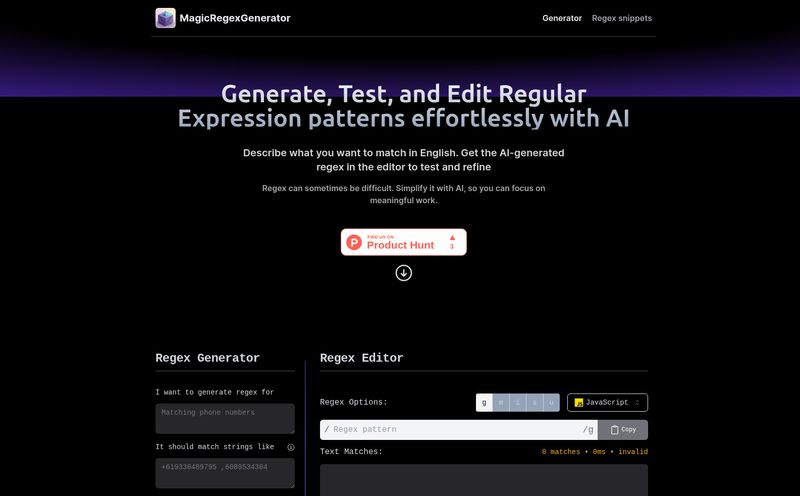For the past couple of years, my world has been completely saturated with AI. AI this, AI that. It’s the new gold rush, and every developer, marketer, and their dog is trying to stake a claim. But behind the glitz of chatbots that can write poetry and image generators that create nightmare fuel, there’s a pretty big problem brewing: centralization.
Most of the heavy-hitting AI models are locked up in the digital fortresses of a few tech giants. It's their hardware, their data, their rules. For the little guy—the brilliant AI innovator working from their garage or the small business that needs a custom solution—getting a foot in the door can feel impossible. The cost is insane, the red tape is endless, and you're always playing in someone else's sandbox.
This is the itch that a new project called Openfabric is trying to scratch. I’ve had my eye on it for a while, and it’s one of those ideas that’s either completely brilliant or brilliantly bonkers. They're talking about creating an “internet of AI” using blockchain. Yeah, I know, when you hear “blockchain,” half of you probably get excited and the other half rolls your eyes. I get it. But stick with me, because what they’re proposing is actually quite compelling.

Visit Openfabric AI
So What Exactly Is Openfabric?
In the simplest terms, Openfabric wants to be the foundational layer—a Layer 1 for Artificial Intelligence. Think of it like this: if AI applications are cars, then Openfabric wants to build the entire highway system they run on. A decentralized, global network where anyone can build, share, and use AI.
Instead of one company controlling everything, it creates an open market. It’s designed to be a meeting point, a digital crossroads where different groups can finally work together without a massive corporation acting as a middleman. It’s a pretty ambitious goal, aiming to wire together the three crucial pillars of the AI world.
The Big Idea: Connecting the AI Ecosystem
I’ve always felt the biggest barrier in tech isn't the technology itself, but getting the right people to talk to each other. Openfabric seems to understand this. Their entire platform is built to connect:
- AI Innovators: These are the brains of the operation. The coders and data scientists creating amazing new algorithms. On Openfabric, they can upload their creations to a marketplace, get feedback, and actually monetize their work without needing massive corporate backing.
- Data Providers: AI is hungry, and its food is data. People or companies with valuable datasets can provide them to the network, helping train better models and potentially earning revenue in the process. It creates an incentive for sharing high-quality data.
- Infrastructure Providers: Running complex AI requires some serious computing power. Individuals and data centers can lend their hardware (GPUs, CPUs) to the network and get rewarded for it. It's like Airbnb, but for computational power.
When you see it laid out like that, it just… makes sense. It’s a symbiotic loop. More infrastructure allows for more complex AIs, which require more diverse data, which in turn attracts more users and innovators. That’s the dream, anyway.
Key Features That Caught My Eye
The AI Apps Marketplace
This is the heart of the platform for me. It’s essentially an App Store for AI. Imagine browsing a library of AI applications, from simple text analyzers to complex predictive models, and being able to deploy one for your business with a few clicks. For businesses, this lowers the barrier to adopting AI significantly. For developers, it provides a direct path to an audience. It’s a win-win, and a far cry from the current mess of custom integrations and sky-high consulting fees.
Built on Blockchain: More Than Just Hype?
Let's be real, tacking “blockchain” onto a project is a classic marketing move. But here, it seems to have a real purpose. Using a decentralized ledger provides transparency. You can theoretically see how an AI model was trained, what data it used, and how it’s being run. This is a huge deal for things like security and fighting algorithmic bias. It also handles the payments and rewards flowing through the ecosystem automatically, which is kind of elegant. I do worry about the learning curve, though. Blockchain is not exactly user-friendly, and that could scare some people off. It's a double-edged sword.
Staking and Tokenomics: Getting Involved
Naturally, there’s a token, the $OFN token. It's the fuel for the network, used for transactions, staking to secure the network, and participating in governance. This is where the crypto-savvy folks can get involved on another level, by becoming validators or staking their tokens to earn rewards. Now, a word of caution. The website itself currently has a banner about an “OFN token issue” they are investigating. This is a stark, if unintentional, reminder that this is still the wild west. The potential is high, but so are the risks. It’s part of the territory with any new and ambitious project in the Web3 space.
Okay, So What’s the Catch? A Realistic Look
I wouldn't be doing my job if I just painted a rosy picture. While the vision is exciting, Openfabric is still a fledgling. It's a new platform, and gaining critical mass—getting enough developers, data providers, and users—is the classic chicken-and-egg problem for any network. Its success rests entirely on building a vibrant community.
Plus, some core features, like the Mainnet Explorer and the Validator functions, are still listed as “Soon.” That’s startup code for “we’re working on it,” which means early adopters need to be patient. You're not buying a finished product; you're backing a vision. For some, that's a deal-breaker. For others, its the most exciting time to get in.
What About The Pricing?
Here’s the short answer: we don’t know yet. The pricing page URL is empty and there's no public information on costs. This isn't surprising for a platform at this stage. I'd speculate that it will likely involve a transaction-based model, where the platform takes a small percentage of the fees paid for AI services or computational power. For businesses, this would still likely be a fraction of the cost of developing an in-house solution or hiring a major AI firm. But for now, it's all just speculation.
Who Is Openfabric Really For?
So, who should be paying attention to this? I see a few key groups.
First, AI developers and data scientists who feel constrained by the current ecosystem. This could be their chance to build, innovate, and get paid without a gatekeeper. Second, businesses and enterprises that want to integrate AI but are put off by the cost and complexity. The marketplace could be a game-changer for them. And finally, crypto and Web3 enthusiasts who believe in the power of decentralization and are looking for the next big infrastructure play. If you fall into one of those camps, Openfabric should absolutly be on your radar.
Frequently Asked Questions
- What does 'Layer 1 for AI' actually mean?
- Think of it as the base-level blockchain protocol, the fundamental infrastructure upon which other AI applications and services can be built. Just like Ethereum is a Layer 1 for decentralized finance (DeFi), Openfabric aims to be the Layer 1 for decentralized AI.
- How does Openfabric help AI developers?
- It gives them a platform to directly monetize their algorithms in an AI Apps Marketplace. They can access distributed computing power and diverse datasets, removing many of the financial and logistical barriers they currently face.
- Is Openfabric a good investment?
- That's a tricky question. As a professional blogger, I can't give financial advice. The project has a ton of potential, but it's also very new and carries risk, as evidenced by the token issue mentioned on their site. You should do your own thorough research, read their whitepaper, and understand the risks before considering any investment in the $OFN token or the ecosystem.
- Can I use AI apps from Openfabric without knowing about blockchain?
- Ideally, yes. The goal of a well-designed platform like this is to abstract away the complexity. A business user should be able to browse the marketplace and deploy an AI app without ever needing to understand the underlying blockchain mechanics. The user experience will be the ultimate test of their success.
- What is the OFN token used for?
- The OFN token is the native utility token of the Openfabric ecosystem. It's used to pay for services (like using an AI app or computational power), for staking to help secure the network, and for participating in governance decisions about the platform's future.
Final Thoughts: A Glimmer of the Future?
So, is Openfabric the future? Maybe. It’s a bold, ambitious swing at a very real problem. I love the vision of a democratized AI landscape where innovation can flourish anywhere. It’s what the internet was supposed to be all about in the first place, right? Open. Collaborative. Accessible.
Of course, the road from a slick website and a compelling whitepaper to a thriving global network is long and fraught with peril. They have to nail the tech, build the community, and deliver on their promises. But I'm an optimist. I'll be watching Openfabric closely, because if they can pull this off, it won’t just be another cool platform. It could be the start of a whole new chapter for artificial intelligence.
Reference and Sources
- Openfabric Official Website
- Forbes: Web3 Is On The Verge Of Revamping The AI Industry (Article mentioning Openfabric)



